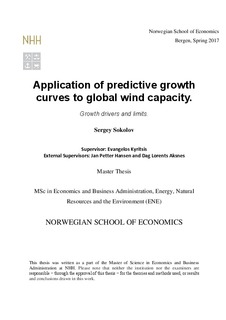Application of predictive growth curves to global wind capacity : growth drivers and limits
Abstract
Global primary energy demand is likely to increase by half between 2015 and the middle of
the 21st century, which will require new energy capacity to cover growth in consumption.
Current primary energy supply is dominated by fossil fuels. These sources are limited in
quantity and are unevenly distributed on our planet. Additionally, burning fossil fuels creates
a negative externality, causing global warming. The international community has agreed, that
increased use of fossil fuels to tackle future energy deficit is unsustainable in the long run.
Wind power is an unlimited, clean energy resource, which in theory could partly solve the
problem of energy shortage.
This work analyzes the dynamics of wind power capacity at global and regional level. The
main finding is that wind capacity follows a logistic growth trend. This gives an opportunity
to discover the saturation level and forecast cumulative installed wind capacity into the first
half of the 21st century. The study predicts that wind power will cover less than 1% of global
primary energy demand in year 2040. The thesis also points to the key drivers of wind capacity
and outlines the contribution of those drivers to the forecast for wind power capacity in year
2040.
